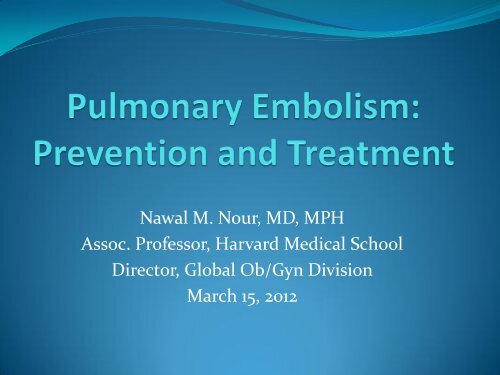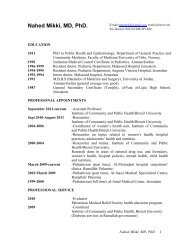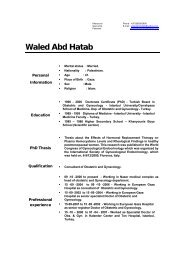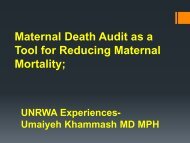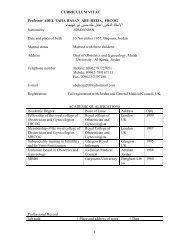download presentation - Gyn Bethlehem 2012
download presentation - Gyn Bethlehem 2012
download presentation - Gyn Bethlehem 2012
- No tags were found...
You also want an ePaper? Increase the reach of your titles
YUMPU automatically turns print PDFs into web optimized ePapers that Google loves.
Nawal M. Nour, MD, MPHAssoc. Professor, Harvard Medical SchoolDirector, Global Ob/<strong>Gyn</strong> DivisionMarch 15, <strong>2012</strong>
Maternal Mortality in Palestine• 23 deaths• Second leading cause of death (after MI)• All deaths occurred in the hospital• 53% were between 20-29 years• Highest maternal mortality rate in women >40(143.74/100,000)• 65% deaths occurred in postpartum period• 6 occurred within 24 hours• 10 occurred within 1 week
Maternal Mortality in Palestine• 9 cases (64%) – cesarean section• 6 cases (35%) – vaginal delivery• 8 cases – died of direct causes• 5 PE• 1 Hemorrhage• 1 Eclampsia• 1 Ectopic• 11 cases – died of indirect causes• 7 from H1N1/pneumonia
Maternal Mortality in Gaza• 30 deaths in 2008-2009• 6 PE (20%)• 6 Heart disease (20%)• 5 Hemorrhage (16.7%)• 5 Sepsis (16.7%)• 3 PIH (10%)
Pulmonary Emboli• Deep venous thrombosis and PE are often preventable• Pregnancy and postpartum are risk factors for venousthromboembolism (VTE)• Industrialized nations – decline in MMR• Incidence of VTE: 85/100,000• DVT 3x more common than PE• But VTE 5x more likely in postpartum period• PE 15X more likely to occur in postpartum period• DVT twice as high after C/S than VD
Risk factors• Cesarean section, premature delivery, h/o cardiacdisease and multiple gestation• High risk patients have deficiencies in:• Antithrombin• Protein C• Protein S• Mutations in genes:• Factor V Leiden• Prothombin• Presence of antiphospholipid antibodies
Diagnosis DVT• Symptoms: calf/thigh pain• Signs: Leg calf >2cm than other• Doppler ultrasound (venous color)• MRI – if suspect pelvic thrombosis• Ascending contrast venography considered goldstandard, but rarely used because invasive• If positive – treat immediately
Diagnosis of PE• Could do doppler to evaluate DVT, if positive treat. But
Treatment• Heparin: pts with elevated risk of bleeding, hypotension orrenal failure• For PE: treat IV first then switch to sc• For DVT: 5,000 IU bid• Low-molecular weight heparin• Enoxaparin 1 mg/kg q 12 hours (anti-Xa level 1-2 IU/mL)• Switch to sc heparin at 36 weeks• Consider an inferior vena cava filter• Patient bleeding after surgery or has stroke• Anticoagulation ineffective or complications• Patient suffered a massive PE
Prevention• Check family history of PE, if positive, consider testingfor thrombophilia and mutations• Check for patient history of DVT or PE• Take patient’s complaints about calf pain seriously• American College of Chest Physicians guidelines forthromboprophyslaxis• Prior episode VTE (DVT or PE)• Antithrombin deficiency
Prevention• Case-by-case basis for thromboprophylaxis• One episode of VTE with pregnancy or contraception• One episode of idiopathic VTE• One episode of VTE with thrombophilia• What to do during a cesarean section?• One risk factor - pneumatic compression• ALL patients should either have compression stockingsor pneumatic compression
Compression vs Pneumatic boots
Prevention/Treatment• What to do after a delivery?• With risk factors:• Heparin restart 12 hours after cesarean section• Heparin restart 6 hours after vaginal birth• 6 months of anticoagulation therapy
Summary• PE is a serious contributor of maternal mortality inPalestine• Many PE’s are preventable now that we are aware ofthe situation• Obtain family history and patient’s history• Use compression stockings on every patient who ishaving a cesarean section• Encourage early ambulation after delivery


